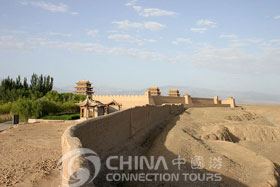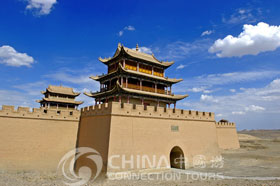 Jiayuguan Pass stands in the southwest part of Jiayuguan City, about 6 km away from downtown. The castle was begun in 1372 in the Ming Dynasty and located in the Jiayu Highland, hence its name Jiayuguan Pass. It is situated between the Wenshu and Heishan Mountains at the foot of Jiayuguan Hill of Qilian Mountain. It is the first pass at the west end of the Great Wall of China and is well-known as "the Impregnable Pass under the Heaven". It is also the most magnificent and best-preserved pass among the total over one thousand passes along the Great Wall of China. It one welcomed Zhang Qian, an official who visited the West as a diplomat of China in the Western Han dynasty (206 B.C.-A.D. 25), Ban Chao in the Eastern Han dynasty (A.D. 25-220), an imperial envoy to Central Asia, and later Xuan Zhuang, the eminent Buddhist pilgrim of the Tang dynasty (618-907) who traveled to India in quest of Buddhist scriptures. Besides, the famous Silk Road also passed through here.
Jiayuguan Pass stands in the southwest part of Jiayuguan City, about 6 km away from downtown. The castle was begun in 1372 in the Ming Dynasty and located in the Jiayu Highland, hence its name Jiayuguan Pass. It is situated between the Wenshu and Heishan Mountains at the foot of Jiayuguan Hill of Qilian Mountain. It is the first pass at the west end of the Great Wall of China and is well-known as "the Impregnable Pass under the Heaven". It is also the most magnificent and best-preserved pass among the total over one thousand passes along the Great Wall of China. It one welcomed Zhang Qian, an official who visited the West as a diplomat of China in the Western Han dynasty (206 B.C.-A.D. 25), Ban Chao in the Eastern Han dynasty (A.D. 25-220), an imperial envoy to Central Asia, and later Xuan Zhuang, the eminent Buddhist pilgrim of the Tang dynasty (618-907) who traveled to India in quest of Buddhist scriptures. Besides, the famous Silk Road also passed through here.
 The pass takes the shape of a trapezoid and has a good layout with a three-storied gate tower and 4 corner towers. Jiayuguan Fort is surrounded by an inner and an outer wall and further protected by trenches. It is of great strategic values in ancient times. In ancient times, Jiayuguan Pass was the only route for soldiers and armies to go to the west.
The pass takes the shape of a trapezoid and has a good layout with a three-storied gate tower and 4 corner towers. Jiayuguan Fort is surrounded by an inner and an outer wall and further protected by trenches. It is of great strategic values in ancient times. In ancient times, Jiayuguan Pass was the only route for soldiers and armies to go to the west.
Jiayuguan Pass is not only endowed with geographical advantages, but excellent topographical and environmental features. It faces the Gobi, a vast open terrain that once served as a battle ground in ancient times. To its south is the trubulent Taolai River and the Wenshu Mountain and on its inner side lies a smooth terrain made of oases, fertile pasture land with adequate water sources.
What's more, the castle is also of great architectural and cultural value and its towers and pavilions are of great beauty. The pagoda-style roof adds to the grandeur of the castle.

